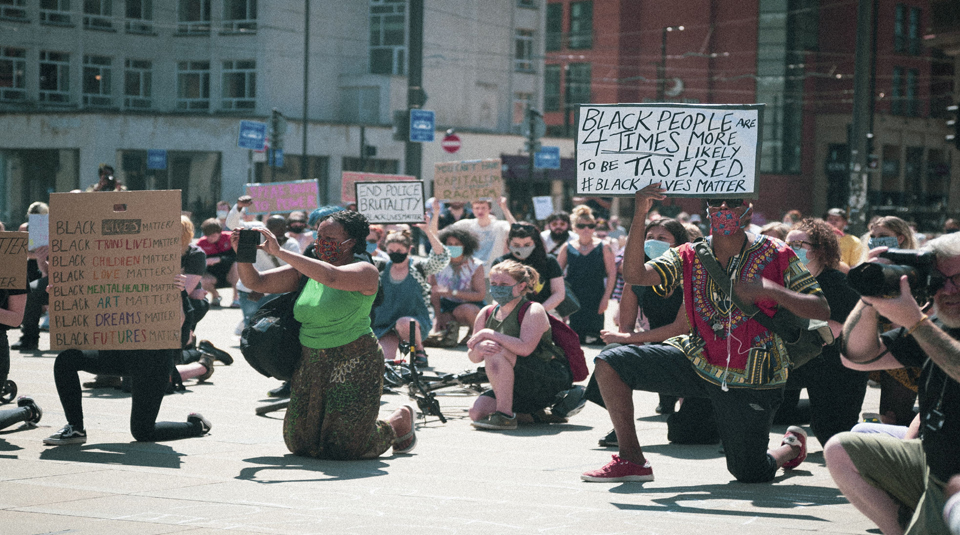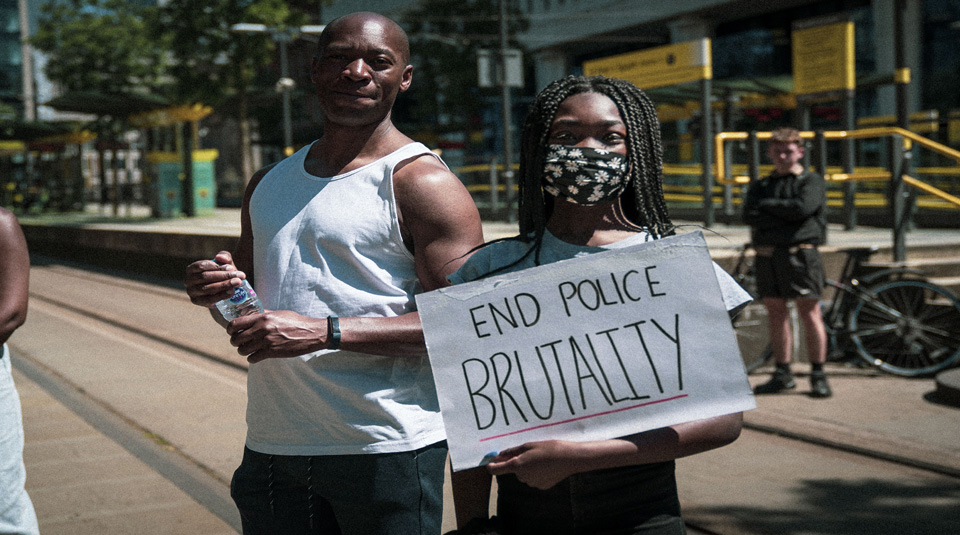At a time when people’s right to protest is being challenged, we’ve a fascinating read from Holly Barrow, Political Correspondent for the Immigration Advice Service, exploring the use of surveillance to suppress dissent.

Just a few weeks ago, it became public knowledge that UK police departments had admitted to using drone surveillance to monitor protests across the country, from Black Lives Matter (BLM) protests during summer 2020 to climate crisis and animal rights demonstrations. UK Drone Watch submitted freedom of information (FoI) requests to all regional police forces last November regarding their use of unstaffed aircraft to monitor protests; ten admitted to this, while a number of forces refused to answer. All the police forces questioned refused to disclose details of their covert use of drones.
Regrettably, the use of technology to surveil public protests is no new phenomenon. Facial recognition technology and drones have been increasingly incorporated into policing to monitor, track and identify members of the public. Despite evidence that the use of such technology in legal political protests poses significant problems – such as infringing on privacy, disproportionately targeting marginalised groups and interfering with the right to assemble freely – there continues to be little regulation of its use.
This isn’t an issue unique to the UK. When George Floyd was tragically murdered in June 2020 by Minneapolis police detective Derek Chauvin, the US erupted into protest which soon rippled across the globe. During the US protests against police brutality and systemic racism, it soon came to light that US police departments were relying on drone surveillance to identify protesters and monitor activity. U.S. Customs and Border Protection (CBP) was discovered to be flying a large, military grade drone above Minneapolis, as well as piloting surveillance aircraft over similar protests in Washington, D.C. and 13 other cities. Federal agents were able to view live aerial footage on their phones and to store the footage for potential use in criminal investigations.
Only recently did it become clear that UK police departments had been taking the same approach.
Those who advocate for the use of drone technology for security purposes often argue that using drones to monitor public activity is no different to people being observed by strangers when in public spaces.
A 2017 report by Statewatch argues that this is not the case and makes four clear distinctions: firstly, that surveillance can be prolonged and sustained, taking place over a period of time or across significant distance; secondly, that it can be targeted at individuals in a way that removes their sense of public anonymity; thirdly, that it can be carried out in proximity, invading personal space; and finally, that conspicuous attention from uniformed police officers can diminish perceptions of protest legitimacy in a way that observation from others would not.
The idea that police surveillance is no different to any other form of observation during public protests is inherently flawed, given the drastically different power dynamics at play. The public has virtually no knowledge of what police departments do with this surveillance footage – receiving little indication as to where the footage is stored, for how long, and what the consequences may entail. It is unclear who can access this data and which government departments police may share it with – this lack of regulation and failure to consult the public on the matter poses significant concerns.

Not only does technological surveillance pose a threat to privacy, it has similarly faced scrutiny for disproportionately targeting marginalised people and amplifying racist policing. It is ironic that such forms of police surveillance were employed to monitor BLM protests against police brutality, when these very technologies have been found to perpetuate systemic racism.
Earlier this year, Amnesty launched a global campaign to ban the use of facial recognition systems, arguing that it can be weaponised by law enforcement against marginalised communities.
A 2012 review found that the use of unstaffed aircraft systems such as drones for surveillance purposes typically sees the same ‘usual suspects’ targeted: the poor, people of colour and anti-government protesters. There is real potential for discrimination, with the researchers finding that the use of surveillance technologies often reinforces existing social inequalities, particularly along the lines of race, class, gender, sexuality and age.
Perhaps one of the most crucial arguments against the use of drone surveillance is that it can significantly infringe on the right to protest. Campaigners and activists have described how the rise in technological surveillance seems to coincide with government attempts to suppress dissent.
Liberty – the UK’s largest civil liberties organisation – has campaigned extensively against the use of such technologies to monitor political protests, noting how this can discourage members of the public from exercising their right to demonstrate against injustices.
Rosalind Comyn, Liberty’s Policy and Campaigns Manager, told The Guardian: ‘Recent years have seen a concerted attack on the right to protest from police and government […] Increased mass surveillance, whether through drones or other developing tools like facial recognition, is designed to intimidate and control, and ultimately silence dissent.’
For migrants and refugees, for example, the ambiguity surrounding who has access to police surveillance footage serves to intimidate. If such data is shared with departments such as the Home Office, this could prove detrimental and may be used against them. The lack of clarification on whether police surveillance is shared with areas of the government can play a key role in dissuading people from participating in campaigns.
It is imperative that public debate and engagement on this issue is prioritised. As it currently stands, surveillance technology is unregulated, leaving it open to misuse, abuse and corruption. Work must also be done to tackle pre-existing issues with technology such as facial recognition, which has already been criticised for perpetuating racial discrimination.
Not only do police departments intend to continue using drones, so too do private companies such as Amazon. There must be greater clarity on what this involves and how it may impact civil liberties.
Holly Barrow is a political correspondent for the Immigration Advice Service – an organisation of UK & Ireland immigration lawyers providing help with UK visas, settlement and citizenship.
Guest blogs are not curated by PHM but feature voices on topics relevant to the museum’s collection. Guest blogs do not necessarily reflect the views of PHM.
Contemporary collecting continues to be an important focus for PHM, as we ensure that the museum’s future collections reflect the unprecedented events and collective action of 2020. You can find out about some of the museum’s recent exhibitions and contemporary collecting on Google Arts & Culture.
PHM’s 2019 programme explored the past, present and future of protest, marking 200 years since the Peterloo Massacre. Find out how PHM Programme Officer Michael Powell and his team created the Protest Lab space, and get an insight into which contemporary objects were collected for display. The exhibition was supported by The National Lottery Heritage Fund.
If you’d like to find out more about migration at PHM, read PHM Researcher Dr Shirin Hirsch’s blog which takes a closer look at the history of migrant workers documented in the museum’s collection or see the full programme of events and exhibitions exploring migration.
Don’t miss Tape Letters: hidden stories of migration, this month’s Radical Late online, 7.30pm to 9.00pm on Thursday 8 April, to explore hidden stories of migration through a series of deep listening sound videos, developed from testimonies collected by Modus Arts during their Tape Letters project. The event concludes with a live Q&A session.
People’s History Museum (PHM) is planning to reopen from Wednesday 19 May 2021, in line with the government’s latest roadmap. The opening hours for the museum will be Wednesday to Sunday, 10.00am to 4.00pm, and entry is free with a suggested donation of £5.